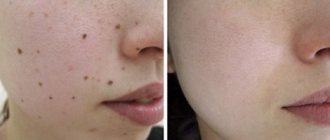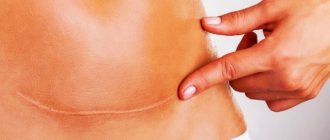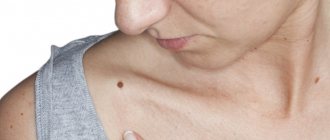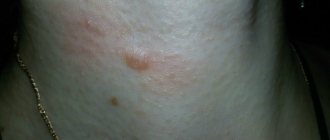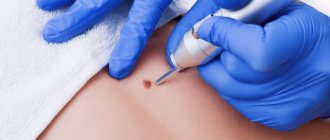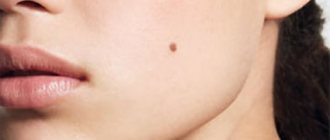03/07/2018 There is a risk of a scar appearing on the skin after surgery. The smaller the area and depth of the damage, the less likely it is to occur. Is it possible to guarantee that a scar will not appear or to cure it completely?
This is an article by Mikhail Gusarov, member of the European Academy of Dermatology and Venereology (EADV), International Dermatoscopy Society (IDS), author of more than 10 scientific publications.
What determines the risk of scarring?
The appearance of a scar and its nature depends on a number of factors:
- Depth and area of damage: if they are small, a scar may not appear at all.
- Tissue healing abilities.
- The presence of chronic diseases (for example, diabetes).
- Time for complete healing of the wound (it may increase if the wound has become infected).
The process of complete wound healing, which lasts for 21 days, ends with pathological scarring in only 33% of cases. If the process lasts more than 21 days, the probability increases to 78%.
Consultation
A critical part of preparing for scar excision surgery is being well informed and having realistic expectations regarding the outcome, possible risks, and postoperative circumstances. Great care should be taken to describe the procedure for performing scar excision surgery and what the patient can expect after it is performed. During the consultation, it is important to convey to the patient that it is not possible to completely remove the scar; it can be made less noticeable and positioned in the right direction. It is also important to discuss the healing process after surgery and how it should progress.
How does a wound heal?
The following phases of wound healing are distinguished:
- Inflammation. It begins immediately after the injury and lasts about 2-3 days, during this phase it is necessary to clean the wound and carry out anti-infective measures.
- Proliferation. From 3 days to 2 weeks. It is necessary to maintain the absence of infection and adequate hydration.
- The appearance of a scar. From 2 weeks to several years. During this phase, measures are taken to correct the scar depending on its type. [12]
Myth 1. Scars disappear on their own.
Scars do not disappear on their own. They need to be treated or corrected. There are many different surgical and conservative techniques for this.
There are several stages of scar formation:
- Stage I - inflammation and epithelization (7-10 days after injury). Post-traumatic inflammation of the skin gradually decreases. The edges of the wound are connected to each other by fragile granulation tissue; there is no scar as such yet. This period is very important for the formation of a thin and elastic scar in the future - it is important to prevent suppuration and divergence of the edges of the wound.
- Stage II - formation of a “young” scar (10-30 days after injury). Collagen and elastin fibers begin to form in the granulation tissue. Increased blood supply to the area of injury remains - the scar is bright pink. During this period, repeated external trauma and excessive physical effort should not be allowed.
- Stage III - formation of a “mature” scar (up to 1 year).
The number of vessels decreases - the scar thickens and becomes pale. Physical activity is allowed to the usual extent. Before 1 year, the final transformation of the scar occurs. Scar tissue slowly matures - blood vessels completely disappear from them, collagen fibers line up along the lines of greatest tension.
If the process of wound healing and scar formation proceeded without complications, then the scar becomes light, elastic and almost invisible, that is, normotrophic. Normotrophic scars do not disappear, but if you follow your doctor’s recommendations for scar care, they usually become almost invisible. Hypertrophic and kelod scars must be treated.
You should know that the formation of scar tissue is characterized by certain stages of development: extensive growth, plateau, spontaneous regression of the scar. The positive effect observed with long-term use of any anti-scar drug may coincide in timing with the natural stage of regression of scar tissue and mislead the specialist and the patient in good faith.
Find out which method of correcting scars and stretch marks is optimal for you!
doctor Svetlana Viktorovna Ogorodnikova.
doctor
Is a scar a reason to go to the doctor?
Reasons for visiting a doctor:
- aesthetic dissatisfaction;
- itching and pain in the scar area;
- the formation of deformities and contractures, which can lead to disability.
If scar tissue begins to develop pathologically and causes a keloid scar, it is better to consult a doctor.
There are factors that increase the risk of developing a scar:
- genetic predisposition;
- race (black patients are more likely to develop keloids);
- localization of injury (when removing tumors in the chest, neck and shoulders, the likelihood of keloid scars is higher);
- age (the formation of keloid scars is typical for young people). [3]
Before and after. How we remove scars
Before surgery
Before the operation, the patient must undergo tests and undergo all necessary examinations. If you plan to perform an operation under anesthesia, you must meet and talk with an anesthesiologist - the doctor who will administer anesthesia. It is also advisable to take vitamins before surgery and eat well, eating enough meat, fruits and vegetables. Moderation in alcohol consumption before and after surgery is recommended. Before undergoing surgery, it is important for the patient to tell their doctor about all medications they are taking. In the preoperative period, it is often necessary to stop taking medications that reduce blood clotting. These include acetylsalicylic acid (aspirin), a standard ingredient in painkillers. It is also important to inform the doctor about all allergic reactions that the patient has, in particular to novocaine and lidocaine.
How to prevent the appearance of a keloid scar?
There are several ways to prevent the appearance of a keloid scar.
- If surgical excision of the tumor is performed, techniques that minimize tension on the wound edges should be used during suturing.
- Mechanical stabilization - the use of special silicone plates or the use of silicone-based gels.
- The use of various medications containing flavonoids - substances obtained naturally from various plants (for example, onion extract). However, data on the effectiveness of this group of drugs is contradictory.
- Pressure therapy (compression) – within 15–40 mm Hg. Art. for 23 hours a day for 6 months. Data on the effectiveness of this method are also conflicting.
- Glucocorticosteroids (GCS) - can be used as creams or ointments in the initial stages of scar formation and to prevent its formation, as well as in the form of injections into scar tissue. [4]
Surgical treatment of scar using tissue expander
If the size of the skin flap is insufficient, tissue expanders are used to cover the scar.
The C. Radovan method, later called the tissue expansion method, or balloon dermotension, is often the only way to reduce the size of an existing scar: next to the soft tissue defect on one or several sides, a subcutaneous pocket is created using a skin incision, into which a special device is installed, the so-called expander is an elastic balloon with a port for introducing filler. The skin wound is then sutured. After scarring (usually after 12-14 days), with the help of gradual pumping of the filler (as a rule, saline solution acts as a filler), along with an increase in the volume of the expander, the skin-fat flap above it is gradually stretched. The second stage, after removing the expander, is to cover the defect that occurs after excision of the scar with a stretched skin flap.
What if a scar appears?
Once scar tissue has formed, unfortunately, it will not be possible to completely get rid of it. All medical actions in this case will be aimed at minimizing the manifestations of the scar. The following methods are used to treat formed keloids:
- GCS injections are a popular and effective method for treating keloid and hypertrophic scars. A GCS solution is injected into the scar tissue 1–2 times a month until the expected results appear. Unfortunately, with excessive use of the drug, skin atrophy may develop at the injection site, telangiectasia or an atrophic scar may appear. [4]
- Surgical excision of the scar - you should not resort to this method as the only remedy, since it always ends in a relapse that exceeds the existing scar in area. This method can be resorted to after previous long-term therapy carried out in various ways. [4]
- Cryotherapy is the treatment of scars with liquid nitrogen. There are various methods of its use: spray, contact method and intralesional cryoprobe. The latter method is more effective. In addition, the combination of cryotherapy with GCS injections gives the best result compared to others. [4]
- Laser treatment – various lasers are used. Nd:YAG laser with a wavelength of 1,064 nm is used to target the vessels of scar tissue. In addition, CO2 and Er:YAG lasers are actively used in fractional mode. But it is not recommended to use ablative lasers (CO2 and Er:YAG) as the only treatment method, since in this case there is a high probability of relapse. [5]
A dye laser (PDL) with a wavelength of 585 nm is also considered effective. [6]
There is evidence of the effective use of CO2 laser in fractional mode during surgery to improve the cosmetic outcome of healing. [7]
- Ointment with 5-fluorouracil for the treatment of scars, but it is not sold in Russia. [4]
- Botulinum toxin type A is used to weaken the tension of the wound edges by reducing muscle activity. Injections are given immediately after surgery. [8]
- Imiquimod cream is recommended for use after surgical excision of a scar to minimize the likelihood of recurrence. [9]
- Other methods - bleomycin, verapamil, TGF-β, interferon, tacrolimus, sirolimus, tamoxifen, epidermal growth factor, retinoic acid, tamoxifen and other drugs are also considered effective for the treatment of scars. [10]
Conditions for wound healing during scar excision
1. Favorable conditions for scar excision
— scar width (small) — wound edges are mobile and easily approach — the skin surrounding the scar is thin and relaxed — tissue tension at the suture line is minimal and does not increase with movement
2. Unfavorable conditions during scar excision
- the width of the scar is average or significant - the edges of the wound are moderately mobile, and wide mobilization (plasty with local tissues) is necessary to bring them together - the skin surrounding the scar is of medium thickness (thick) - the tissue tension at the suture line is significant, increases with movement
3. Extremely unfavorable conditions during scar excision
- the width of the scar is average or significant - the edges of the wound are inactive and do not come together, or are brought together with considerable effort - the skin surrounding the scar is thick, inactive - the tension of the tissues at the suture line is pronounced, and increases significantly with movement
Which method is the most effective?
Unfortunately, there is no most effective treatment for scars. The most effective is considered to be a combination of various methods, which is always selected individually. Injections of corticosteroids into hypertrophic or keloid scars are considered an accessible, effective and inexpensive method.
Atrophic scars are distinguished separately: for their correction, planar ablative lasers, fractional ablative lasers (CO2 and Er:YAG), various combinations of lasers (fractional +PDL, Qsw+fractional lasers), collagen, fillers with hyaluronic acid, PRP therapy, microneedling are used. , peeling and a number of other methods [11, 12]
Previously, the dermabrasion method was used to correct atrophic scars, but now it is practically not used, since it is associated with the risk of side effects: bacterial or viral complications, telangiectasia, hyperpigmentation, a long rehabilitation period, as well as hypertrophic or keloid scars.
How not to treat scars
Incorrect treatment, in addition to wasting money and time, can lead to enlargement of the scar. What could cause this:
- non-compliance with doctor’s recommendations after removal or self-medication;
- traumatization and irritation of the wound can lead to relapse;
- non-compliance with prescribed antiseptic methods;
- removal of the crust that has formed at the site of removal: under it the restoration process is more efficient.
There is not enough information in scientific sources to evaluate the effectiveness of folk remedies in the treatment of scars. From my experience I can say that I have not seen a single patient for whom folk remedies produced any significant positive changes. And in fairness, it’s worth saying that I rarely encounter the use of folk remedies in the treatment of scars.
On the day of surgery
It is necessary to thoroughly wash the area where the scar is located. It is advisable to avoid the use of cosmetics and lotions. When entering the clinic where the operation will be performed, it is also advisable to leave valuables such as jewelry at home. If the operation is planned to be performed under anesthesia, it is important for the patient that there is no food or liquid in the stomach; for this purpose, it is advisable not to eat or drink anything on the day of the operation. Upon admission to the clinic on the day of surgery, the scar (or scars) are photographed and the patient is taken to the operating room. Types of surgical treatment of scars
Bibliography:
- J Am Acad Dermatol. 2016 Apr; 74(4): 607–25; quiz 625–6. doi: 10.1016/j. jaad. 2015.08.070. Wound healing and treating wounds: Chronic wound care and management. Powers JG, Higham C, Broussard K, Phillips TJ.
- J Am Acad Dermatol. 2016 Apr; 74(4): 589–605; quiz 605–6. doi: 10.1016/j. jaad. 2015.08.068. Wound healing and treating wounds: Differential diagnosis and evaluation of chronic wounds. Morton LM, Phillips TJ.
- Ann Hum Genet. 2022 Feb 27. doi: 10.1111/ahg.12245. Gene-based evaluation of low-frequency variation and genetically-predicted gene expression impacting risk of keloid formation. Hellwege JN, Russell SB, Williams SM, Edwards TL, Velez Edwards DR.
- Int. J. Mol. Sci. 2022, 19(3), 711; doi: 10.3390/ijms19030711. Recent Understandings of Biology, Prophylaxis and Treatment Strategies for Hypertrophic Scars and Keloids. Ho Jun Lee, Yong Ju Jang.
- Br J Dermatol. 2011 Nov; 165(5): 934-42. doi: 10.1111/j.1365-2133.2011.10492.x. Laser and intense pulsed light therapy for the treatment of hypertrophic scars: a systematic review. Vrijman C, van Drooge AM, Limpens J, Bos JD, van der Veen JP, Spuls PI, Wolkerstorfer A.
- Laser Ther. 2013 Dec 30; 22(4): 255–260. doi: 10.5978/islsm.13-OR-20 Laser Scar Management Technique. Takafumi Ohshiro, Toshio Ohshiro, and Katsumi Sasaki
- Arch Dermatol. 2011 Sep;147(9):1108-10. doi: 10.1001/archdermatol.2011.248. A randomized split-scar study of intraoperative treatment of surgical wound edges to minimize scarring. Ozog DM, Moy RL.
- Plast Reconstr Surg. 2022 Mar;141(3):646-650. doi: 10.1097/PRS.0000000000004110. Effects of Botulinum Toxin on Improving Facial Surgical Scars: A Prospective, Split-Scar, Double-Blind, Randomized Controlled Trial. Hu L, Zou Y, Chang SJ, Qiu Y, Chen H, Gang M, Jin Y, Lin X.
- Curr Pharm Des. 2017;23(15):2268-2275. doi: 10.2174/1381612822666161025144434. The Effectiveness of Topical Anti-scarring Agents and a Novel Combined Process on Cutaneous Scar Management. Fang QQ, Chen CY, Zhang MX, Huang CL, Wang XW, Xu JH, Wu LH, Zhang LY, Tan WQ.
- Dermatol Surg. 2022 Jan; 43 Suppl 1:S3-S18. doi: 10.1097/DSS.0000000000000819. Keloids and Hypertrophic Scars: Pathophysiology, Classification, and Treatment. Berman B, Maderal A, Raphael B.
- Clinical and Experimental Dermatology, June 1, 2013. Combination of intense pulsed light and fractional CO2 laser treatments for patients with acne with inflammatory and scarring lesions. B. Wang, Y. Wu.
- Skinmed. 2022 Aug 1; 15(4):271-276. eCollection 2022. Techniques for Optimizing Surgical Scars, Part 1: Wound Healing and Depressed/Atrophic Scars. Konda S, Potter K, Ren VZ, Wang AL, Srinivasan A, Chilukuri S.

